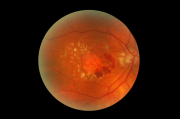Contents |
AMD: Known Risk Factors
Introduction
Age-Related Macular Degeneration (AMD) is one of the leading causes of blindness in Canada and the US. AMD is an irreversible type of progressive degeneration of the area of the retina that is most important for sharp, clear vision. While AMD is not curable, it is possible to reduce the risk of developing this devastating condition and slowing down the rate of progression.
The photograph shows deposits in the retina (light colored spots) and leaking blood vessels (red blotches) which can be seen in macular degeneration.
The Age-Related Eye Disease Study (AREDS) began in the early 1990s and continued over the next several years, studying the causes and prevention of eye disease in the aging population such as cataracts and AMD. AREDS resulted in a wealth of information about the links between various risk factors and later eye disease.
Major risk factors that have been linked to AMD include:
- Smoking
- Poor circulation
- Nutrition and dietary deficits
- Body mass index
- Overexposure to ultraviolet (UV) light
- Genetic susceptibility
- Age
Smoking and Poor Circulation
To stop smoking is one of the most beneficial things a smoker can do for overall health, and maintaining good vision. Smokers are continually being bombarded with information about how much damage tobacco can inflict on the lungs and heart, but little data is provided about the effects of smoking on the eyes. Surveys and studies over the past two decades have established that vision is considered to be the one sense that people are most anxious about losing. Quitting might be easier if the risks it poses to vision and to the eyes are better known; the eyes suffer a bit with each puff.
The outward physical effects of smoke on the eyes, either direct or second-hand, are stinging, watering, increased blink rate, itching and redness, but these are fairly minor problems compared to the damage from the 4000 or so chemicals and toxins that are absorbed into the blood and travel throughout the body.
Smoking effects overall circulation, which has implications for several types of disease in the human body, but in the eyes, lowered circulatory activity can have major effects on vision. Probably the most susceptible of ocular tissues is the macula, that part of the retina that provides us with sharp, clear vision as well as the ability to appreciate color The central area of the retina where the macula resides is vulnerable to damage because the toxins in tobacco smoke are destructive to the tiny blood vessels that nourish that area and carry away metabolic waste products. Smoking reduces the ability of the capillaries to carry oxygen and nutrients everywhere in the body, but the macula’s nutrition is entirely dependent on these smallest of blood vessels; the macula has one of the highest densities of capillaries in the body.
Capillary damage over years of smoking can result in damage that drastically reduces the delivery of oxygen and nutrients, and to carry away the waste products of metabolism from the macula. Over time, the retinal cells in the macular area begin to die, slowly leading to loss of vision which is permanent and irreversible.
Cigarette smoke also lowers the level of plasma antioxidants, substances in the bloodstream that protects cells from erosion and possible scarring. The effects of this type of damage are particularly evident in the macula.
Smoking tobacco has also been linked with the development of cataracts and thyroid-related eye disease, as well as inflammation of the blood vessels in the conjunctiva, the clear skin which covers the white of the eyes and lines the inside of the eyelids.
The good news is that once smoking stops, recovery begins almost immediately. Arteries loosen up, breathing returns to normal, and the retina begins to regain its normal metabolism.
Nutrition and Body Mass Index
Choosing healthy foods is important to overall health, of course, but it is also necessary for maintaining good vision throughout life. In particular, it is important to include leafy green vegetables and foods which contain yellow pigments like corn, squash and egg yolks, because they provide the nutrients lutein and zeanxanthin , which are associated with a lower risk of AMD.
Foods with a high glycemic index, those that cause a rapid rise and drop of blood sugar such as rice, white bread, and pasta are linked with higher incidence of progressive vision loss from AMD, as well as the severity over the course of the disease. More specific information is available in our article titled “AMD: Healthy Eating is Essential for Saving Your Vision.”
A high body mass index, calculated using both height and weight, has been linked through several studies with higher risk of AMD, although it is not totally clear what the exact relationship is.
High Energy Visible Light and Ultraviolet Light
In the age of electronics, high energy visible (HEV) light has gotten the attention of researchers concerned with the long-term effects of our steadily increasing use of computers, cell phones and tablets. HEVL is light at the blue end of the visible spectrum which carries more energy than light at longer wavelengths; the screens of our electronics emit much more light in this area of the spectrum than we would be exposed to otherwise. This type of light can penetrate the structures of the eye and has been shown to cause damage to the retina, contributing to eye conditions like cataracts and AMD. As we spend more hours of the day viewing our monitors, we could be causing damage to our retinas over the long term.
Another concern about HEV light is the growing popularity of LED light bulbs, particularly ultra-blue light versions. New mandates are requiring that LEDs should replace incandescent and fluorescent light bulbs for their high energy saving capabilities, but this could become a major health hazard unless they can be modified to emit lower-energy wavelengths.
Apart from skin damage and sunburn, overexposure to UV light from the sun is linked to both cataracts and AMD. Not visible to humans, UV rays have more energy than visible light and can penetrate ocular tissues more easily, where they can cause damage to the inner lens and the retina, particularly the macular area.
Protecting the eyes from UV rays is relatively simple; the difficulty is in making that protection into a habit so it becomes a routine part of being outside. In order to prevent much UV damage, using a brimmed hat and sunglasses should be second nature, especially with small children.
Damage from UV light is cumulative, causing damage over a long period of time, which makes it hard to see the benefits on an everyday basis. However, over the long term, UV protection helps protect the clarity of vision over a lifetime. For more specific information about UV protection, please see “Ultraviolet Light: Health Hazard.”
Spectacle lenses capable of blocking both UV and HEV light are available and may be recommended for people who have a family history of AMD or have genetically tested to be at high risk of developing it.
Genetic Susceptibility and Age
It is a fact that those who have a family history of AMD are more at risk for developing AMD themselves. Recent research into genetics and DNA indicates that there may be indicators that can be tested; for more information, please see our article titled “AMD: The Role of Genetic Testing in the Use of Ocular Multivitamin Supplements.”
As we age, we are more at risk to develop AMD; unfortunately, there isn’t much one can do to change the fact that we all get older. Only about 2% of the people aged 50 to 59 have AMD, but the percentage increases to nearly 30% by age 75, making age the greatest risk factor for AMD.
Knowledge Really is Power
Knowing what factors raise the risk of AMD late in life can help us to make decisions about how we eat, whether or not we smoke, if we take supplements and protect ourselves and our families from overexposure to UV light. It is possible that we can choose to change in a positive way and still develop AMD, but the chances of doing so are much reduced, as is the rate of progression and the severity of the disease if it does develop.
The advantages of a healthy lifestyle are rewarding in themselves, in the amount of stamina and strength we have, in our energy level, and a healthy immune system to help us ward off communicable disease.







